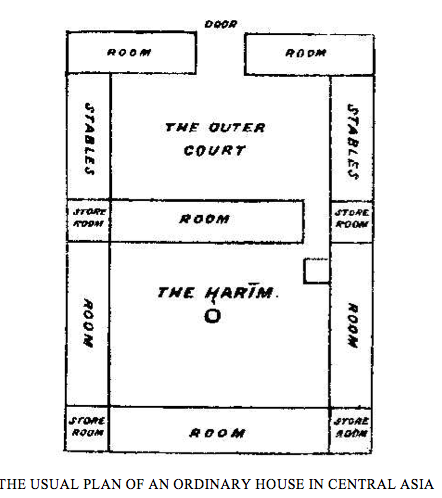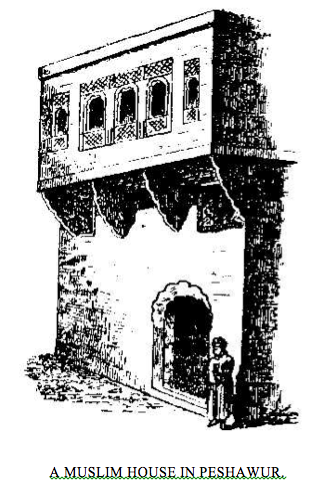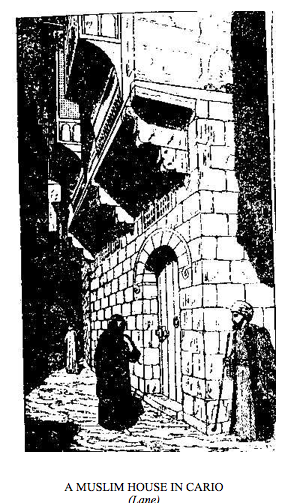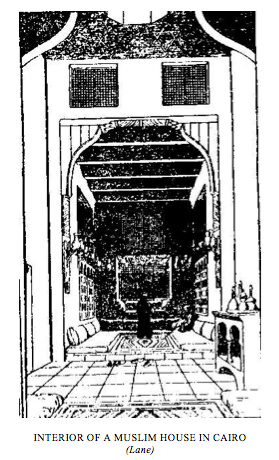pl. buyut; dar دار, pl. diyar, dur; Heb. . In the time of Muhammad the houses of the Arabs were made of a framework of jarid, or palm sticks, covered over with a cloth of camel’s hair, or a curtain of a similar stuff, forming the door. Those of the better class were made of walls of unbaked bricks, and date-leaf roofs plastered over with mud and clay. Of this description were the abodes of Muhammad’s family. (Burton, vol. I. p. 433.)
Sir William Muir, translating from the account given by the secretary of al-Waqidi (Life of Mahomet, new ed., p 546), says:-
“Abdallah ibn Yazid relates, that he saw the house in which the wives of the Prophet dwelt at the time when Omar ibn (‘Abd) al-Aziz, the governor of Medina (about A.H. 100) demolished them. They were built of unburnt bricks and had separate apartments made of palm branches, daubed (or built up) with mud; he counted nine houses, each having separate apartments in the space from the house of Ayesha, and the gate of Mahomet to the house of Asthma, daughter of Hosein. Observing the dwelling-place of Omm Salma, he questioned her grandson concerning it; and he told him that when the Prophet was absent on the expedition to Duma, Omm Salma built up an addition to her house with a wall of unburnt bricks. When Mahomet returned, he went in to her, and asked what new building this was. She replied, ‘I purposed, O Prophet, to shut out the glances of men thereby!’ Mahomet answered, ‘O Omm Salma! Verily the most unprofitable thing that eateth up the wealth of a believe is building.’ A citizen of Medina present at the time, confirmed this account, and added that the curtains (Anglo-Indian pardas) of the doors were of black hair cloth. He was present, he said, when the despatch of the Caliph Abd al-Malik (A.H. 86-88) was read aloud, commanding that these houses should be brought within the area of the Mosque, and he never witnessed sorer weeping than there was amongst the people of that day. One exclaimed, ‘I wish, by the Lord” that they would leave these houses alone thus as they are; then would those that spring up here-after in Medina, and strangers from the ends of the earth, come and see what kind of building sufficed for the Prophet’s own abode, and the sight thereof would deter men from extravagance and pride.”
“There were four houses of unburnt bricks, the apartments being of palm-branches; and
five houses made of palm-branches built up with mud and without any separate apartments. Each was three Arabian yards in length. Some say that they had leather curtains on the doors. One could reach the roof with the hand. The house of Haritha was next to that of Mahomet. Now, whenever Mahomet took to himself a new wife, he added another house to the row, and Haritha was obliged successively to remove his house and build on the space beyond. At last this was repeated so often that the Prophet said to those around him, ‘Verily, it shameth me to turn Haritha over and over again out of his house.'”
The houses of the rural poor in all parts of Islam, in Turkey, Egypt, Syria, Arabia, Persia, Afghanistan, and India, are usually built either of mud or of unburnt bricks. In mountainous parts of Afghanistan they are built of stones (collected from the beds of rivers) and mud. They are generally one storey high, and of one apartment in which the cattle are also housed. The roofs are flat and are formed of mud and straw laid upon branches of trees and rafters. The windows are small apertures, high up in the walls, and sometimes grated with wood.
There are no chimneys, but in the center of the roof there is an opening to emit the smoke, the fire being lighted on the ground in the center of the room. In front of the house there is an inclosure, wither of thorns or a mud wall, which secures privacy to the dwelling. A separate building, called in Asia a hujrah, or guest chamber, is provided for male visitors or guests; this chamber being common property of the section of the village, except in the case of chiefs or wealthy land-owners, who keep hurrahs of their own. In towns the houses of the inferior kind do not differ much from those in the villages, except that there is sometimes an upper storey. In some parts of Afghanistan and Persia, it becomes necessary for each house-holder to protect his dwelling, in which case a watch tower of mud, is erected close to the house. the injunctions of Muhammad regarding the seclusion of women have very greatly influenced the plan and arrangement of Muslim dwelling-houses of the better class throughout the world, all respectable houses being so constructed as to seclude the female apartments from public view. In cities such as Cairo, Damascus, Delhi, Peshawur, and Cabul, the prevailing plan of dwelling-houses is an entrance through a blank wall, whose mean appearance is usually relieved by a handsome door-way and a few latticed windows. A respectable house usually consists
of two courts, the first being that used by the male visitors and guest, and the inner court is the harim or zananah reserved for the female members of the family. Facing the outer court will be an upper chamber, or bala khunah as it is called in Persian, the , or upper room of the New Testament, in which there will be a diwan, or raised seat or sofa, upon which the inmates can sit, eat, or sleep. This is the usual reception room. In Asia, this bala Khanah seems to take the place of the more elaborate qa’ah described by Mr. Lane in his Modern Egyptians, vol. i p. 39, which is either on the ground or upper floor. Within the first enclosure will be the stables for horses and cattle, and in its center a raised dais as seats for servants and attendants. It should be noticed that there are no special bed-rooms in Eastern houses. Male visitors and friends will sleep in the verandahs of the outer court, or on the diwan in the upper court.
The harim or women’s apartments in the inner court is entered by a small door. It is
(Lane)
a quadrangle with verandahs on each of the four sides, formed by a row of pillars, the apertures of which are usually closed by sliding shutters. The back of the rooms being without windows, the only air being admitted from the front of the dwelling-place. The apartments are divided into long rooms, usually four, the extreme corners having small closets purposely built as store-rooms. On festive occasions these verandah rooms will be spread with handsome carpets, carpets and pillow being almost the only furniture of an Eastern dwelling, chairs being a modern invention. The roofs of these rooms are flat, and as the top is fenced in with a barrier some four feet high, the female members of the household sleep on the top of the house in the hot weathers. [HARIM.]
In no point do Oriental habits differ more from European than in the use of the roof. Its flat surface, in fine weather the usual place of resort, is made useful for various household purposes, as drying corn, hanging up linen, and drying fruit.
In the center of the inner court or harim, there is usually a well, so that the female domestics are not obliged to leave the seclusion of the harim for water-carrying. In a large court, of a wealthy person, there is usually a raised dais of either stone or wood, on which carpets are spread, and on which the ladies sit or recline. In the better class dwellings, there are numerous courtyards, and special ones are devoted to winter and summer uses. In Peshawur, most respectable houses have an underground room, called a tah khanah, where the inmates in the hot weather sleep at mid-day. These rooms are exceedingly cool and pleasant on hot sultry days.
Over the entrance door of a Muslim dwelling it is usual to put an inscription, either of the Kalimah, or Creed, or of some verse of the Qur’an.
We have only attempted to describe briefly, the ordinary dwelling-houses of Muslims, which are common to all parts of the Eastern world; but in large wealthy cities, such as Damascus, Cairo, Delhi, and Lucknow, there are very handsome houses, which would require a longer description than our space admits of. For Mrs. Meer Ali’s account of a Muslim harim or zananah, see HARIM.
Based on Hughes, Dictionary of Islam
HOUSES Permission to enter. Arabic isti’zan استذان. To enter suddenly or abruptly into any person’s house or apartments, is reckoned a great incivility in the East , and the law on this subject is very distinctly laid down in both the Qur’an and the Traditions.
Surah xxiv, 27-29:-
“O ye who believe! Enter not into other houses than your own, until ye have asked leave, and have saluted its inmates. This will be best for you; haply ye will bear this in mind.
And if ye find no one therein, then enter it not till leave be given you; and if it be said to you, ‘Go back,’ then go ye back. This will be more blameless in you, and God knoweth what ye do.
There shall be no harm in your entering houses in which no one dwelleth, for the supply of your needs; and God knoweth what ye do openly and what ye hide.”
The traditionists record numerous injunctions of Muhammad on the subject. A man asked the Prophet, “Must I ask leave to go in to see my mothers?” He said, “Yes.” Then the man said, “But I stay in the same house with her!” The Prophet said: “But you must ask permission even if you stay in the same house.” Then the man said, “But I wait upon her!” The Prophet said: “What! Would you like to see her naked?” You must ask permission.”
The Khalifah ‘Umar said it was according to the teaching of the Prophet that if you salam three times and get no reply, you must then go away from the house.
Abu Hurairah says that the Prophet said: “When anyone sends to call you then you can return with the messenger and enter the house without permission.” (Mishkat, book xxii, ch ii, pt 2.)
Based on Hughes, Dictionary of Islam





 © 2025 All Rights Reserved
© 2025 All Rights Reserved